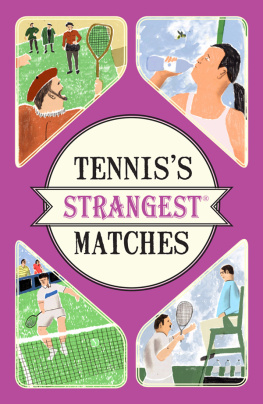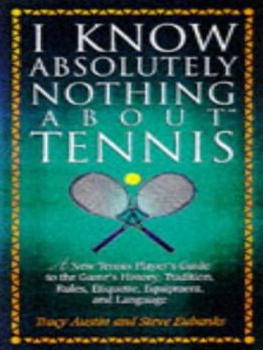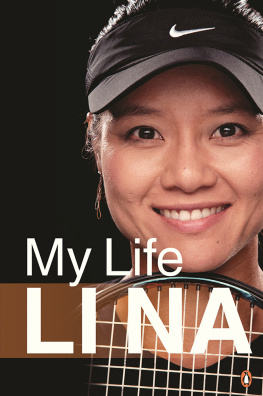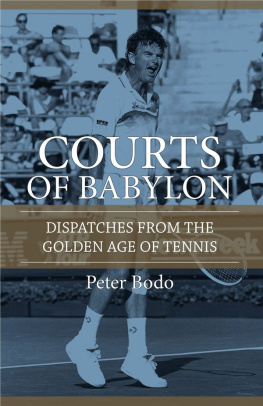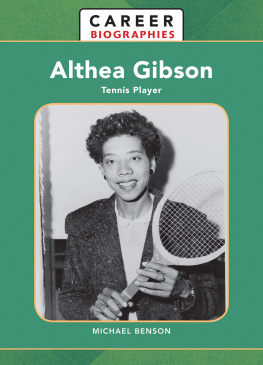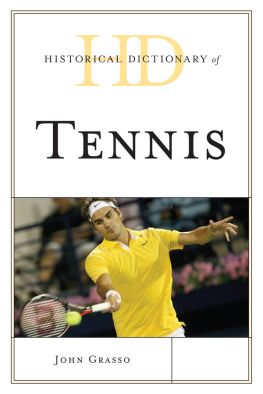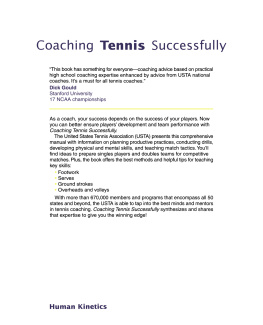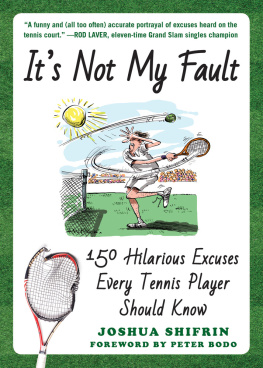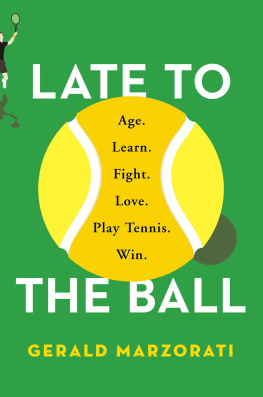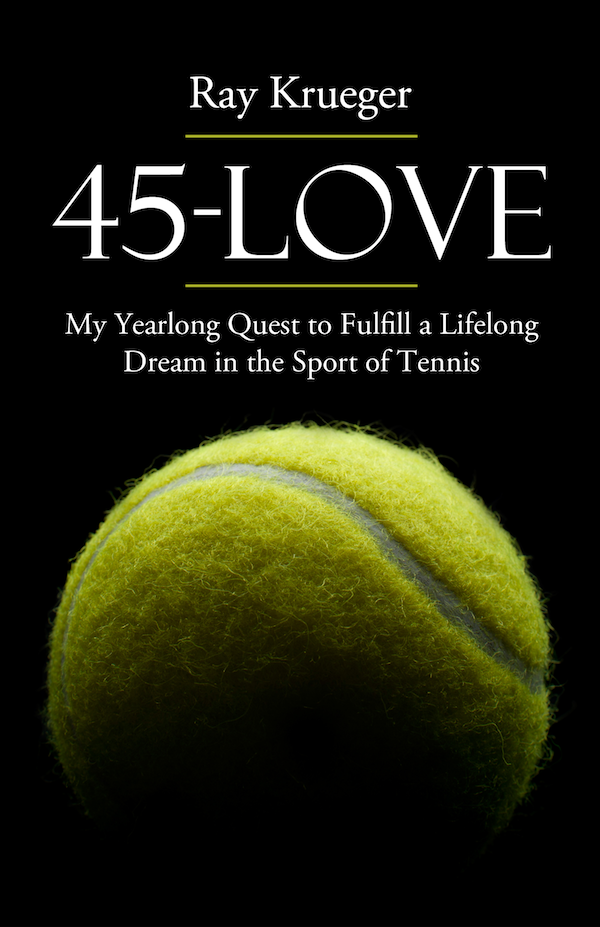Chapter 1
Some people never find a purpose in life. I was lucky. It only took me 17 years to find a sport that would turn into my obsession.
But in a sport where parents hang balls over cribs so infants can develop hand-eye coordination, waiting 17 years to take up tennis seems hopelessly late.
For me, it could not come earlier.
My mother detested all sports. Perhaps it was lingering hatred of my abusive alcoholic father, who I was told was a semi-professional soccer player n Germany.
Whatever the reason, sports was her number 1 waste of time.
Of course, I could not get enough of it.
I went from memorizing the back of baseball cards to creating my own sports statistics for every sport imaginable.
At age 8, I developed a formula for ranking boxers, skiers, racehorses and track stars. Team sports had wins and losses. In my 8-year-old mind, the individual sports needed to be organized, and I was up to the task.
It didnt make a difference if the sport was real or showbiz, as my system even worked for pro wrestlers.
But the system, with graded points for beating the top players and reward points for winning titles seemed best designed for tennis.
I grew up with lots of free time to pursue my sports obsession, which grew into writing small stories about the games I would watch on TV.
I was a latchkey kid before the term was invented. My mother would work nights, so I would come home, lock the door and retreat into my world of sports, statistics, reading and writing.
My mother was not around to stop me. And even when she realized what I was doing, she probably thought it was better than me being on the streets.
Little did she know that I had no desire to leave the house.
My father took off when I was 11, and I knew he was out there somewhere. And I didnt want to run into him, or anybody who might know him.
I wouldnt have to worry, as I would never see or hear from him again.
But my sports obsession was always as an observer, never as a participant.
The kid who played youth baseball and CYO basketball would grow into the worlds most sports obsessed wanna be journalist.
But that kid also grew to be 275 pounds by age 16.
The teasing of that fat kid, made me retreat even more into the sports world of my own creation.
I took a year off from school, claiming respiratory allergies as an ailment that kept me home. It was true, but exaggerated.
The real reason was my fear of the outside world, or rather the world outside of my own mind.
But I knew I would have to go to school eventually. So I decided to lose weight. Eating got me fat, so I decided not eating would get me skinny. So I stopped eating.
I spent a summer break eating three meals a week. Those meals consisted of trips to McDonalds. It worked. I lost 100 pounds in two months. I am the only person who ever used McDonalds to lose weight.
I put most of it back on.
I had failed.
But my world of sports statistics was still there. And if I could not lose weight by not eating, I would find solace in my world.
In the late 70s and early 80s, the subject of ranking in tennis was contentious as systems and formulas were debated at the highest levels of the sport.
But in my mind it was already decided. And since I had that part of the game figured out, I figured playing the game would be just as easy.
My first racket was a Dunlop Maxply, which I bought at Hermans Sporting Goods in Rego Park, Queens.
But getting on a court would have required an opponent, and that was too big a step out of my world.
So I headed to the wall. It wasnt a traditional tennis backboard, but one of those ubiquitous handball walls in New York City.
That is where all the aggression of my childhood situation finally could come out. I would bang that ball into the wall with such force that it would come back at me faster than I could set up for the next shot.
It was not so much a tennis stroke I was developing as the flailings of a madman.
I was a 275-pound teenager beating up a wall with a ball.
On my second day at the wall I smashed the watch on my left wrist with the follow through of my racket.
But in my mind I was ready to make my way onto the court.
But where? Juniper Valley Park had eight hard courts. But it was too intimidating to head out with the real tennis players.
Luckily, my high school, Christ the King, was forming a tennis team. Knowing the kids in my high school were not exactly the tennis type I figured they would not be world beaters. Was I ever right.
Four kids came out for tennis, three short of the minimum to field a team.
We had a fat kid (me), a skinny kid, and a kid from the debating team. The fourth kid seemed to know how to play but quit after seeing how bad we were.
Gary, the kid from the debating team, was a friend, who I helped out with research for his debates.
The only thing that is more dorky than being on the debating team in high school is to be a researcher for the debating team.
We got a book about tennis and proceeded to paint a tennis court in the school parking lot.
It was perfectly proportional, except the service lines extended into the doubles alley.
Our coach, a first-year gym teacher, was no tennis expert, and his qualifications probably consisted of getting us the book. Take that back, I think Gary found the book.
Seeing us eagerly painting the lines, he proclaimed, I am expecting some hardware from this team.
All three of us were new to tennis, but since I had spent so much time banging against the wall, I was confident of my ability.
I volunteered to play number 1 singles. But I still had some stokes to learn, like the backhand. And the serve.
I went to the back of the court and unleashed a killer serve. It went right into the box and skidded under the racket of one of my teammates. It was the best serve I would ever hit in my entire life.
Hardware, my coach exclaimed.
My next few serves were also bullets, but nowhere near the box.
But not to worry. I earned my number one spot.
Our first match was at a clay court tennis bubble across the street from Shea Stadium. I had never seen a clay court, let alone played on one.
There was also the matter of being four players short of a team.
A plan was devised in the athletic department:
If a football player missed a workout or a class they would have to play a match for a tennis team.
The plan was devised to keep the football team in line more than help the tennis team, but it worked for both teams.
After all, what better way to keep a football player out of trouble than to have them have to join the wimpy tennis team if they got out of line.
But we didnt care. It let us field a team, at least until a football player decided he liked being on the tennis team more than playing football and joined us full-time.


